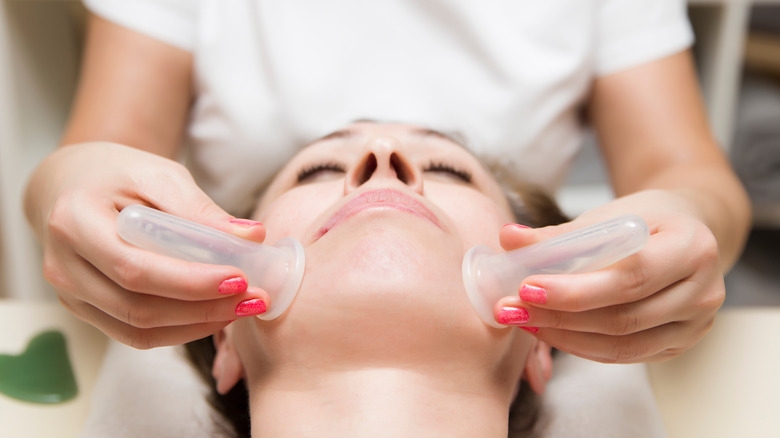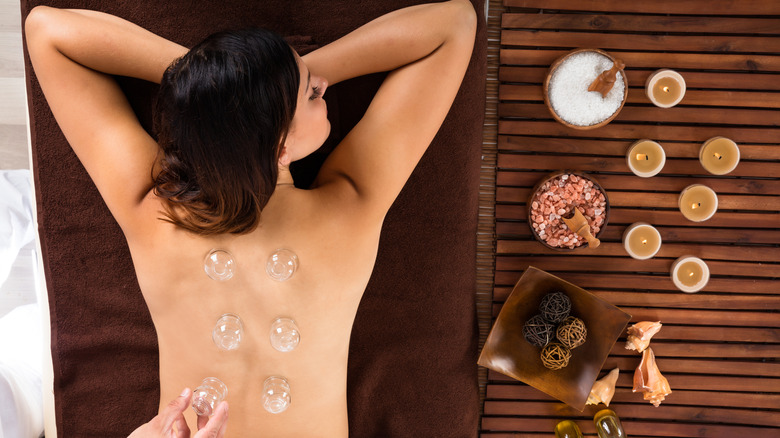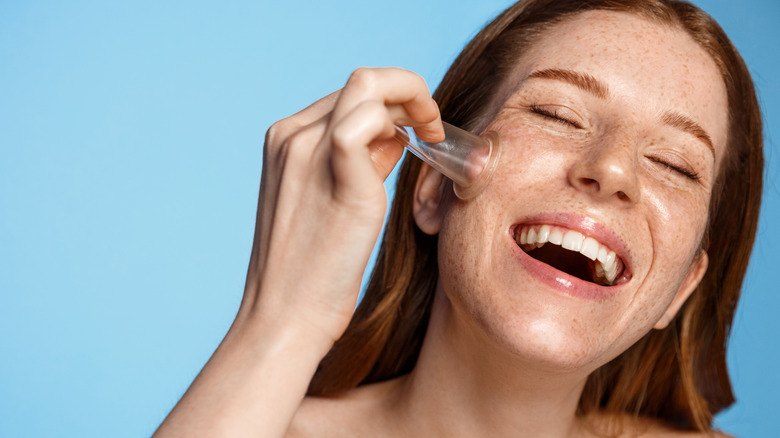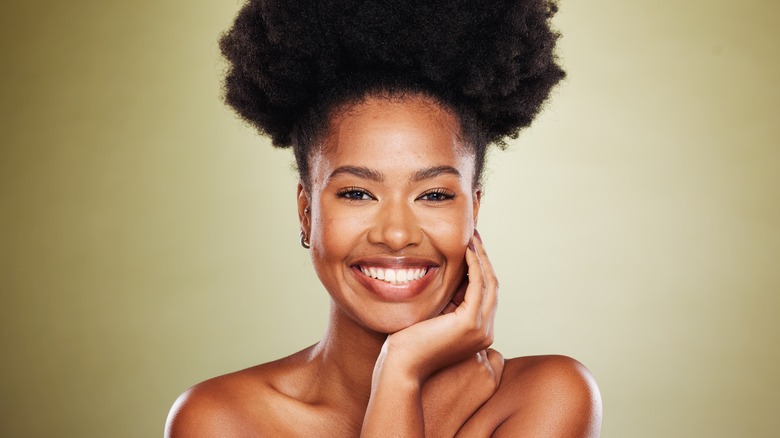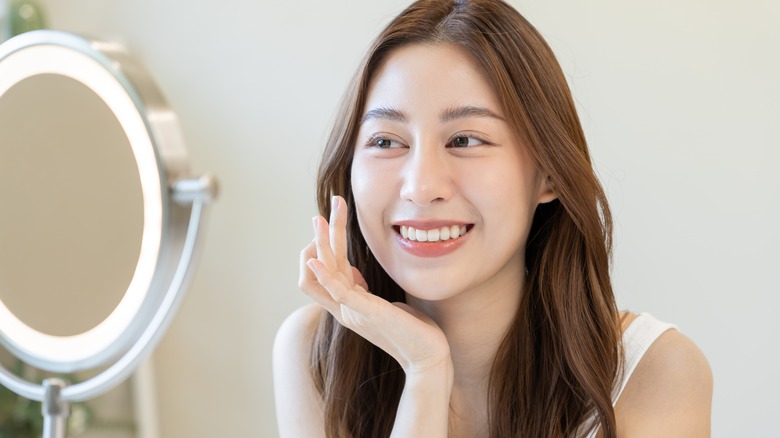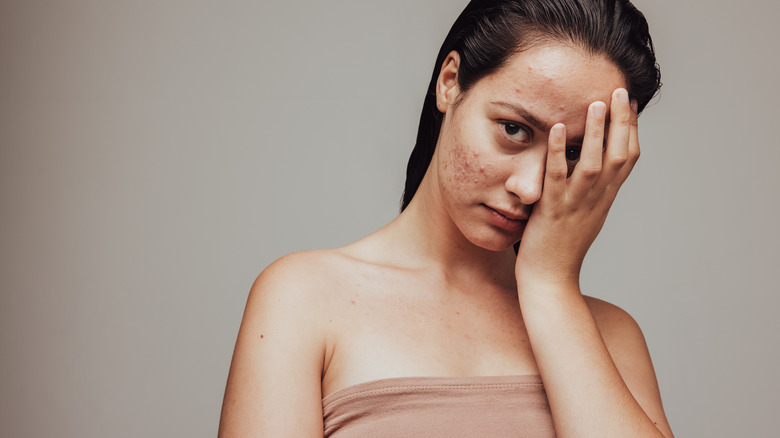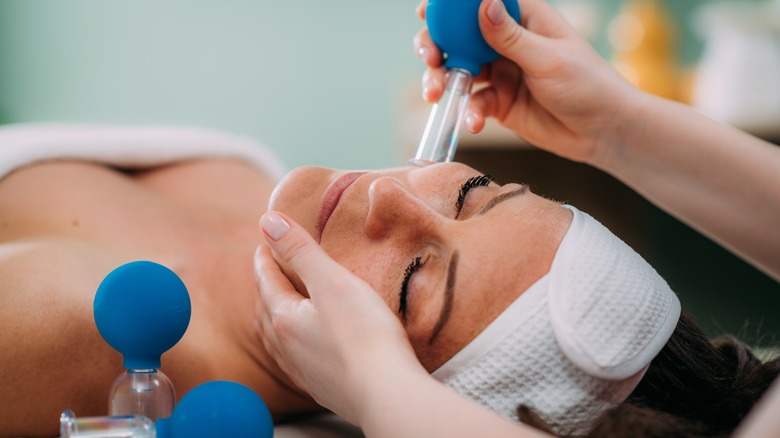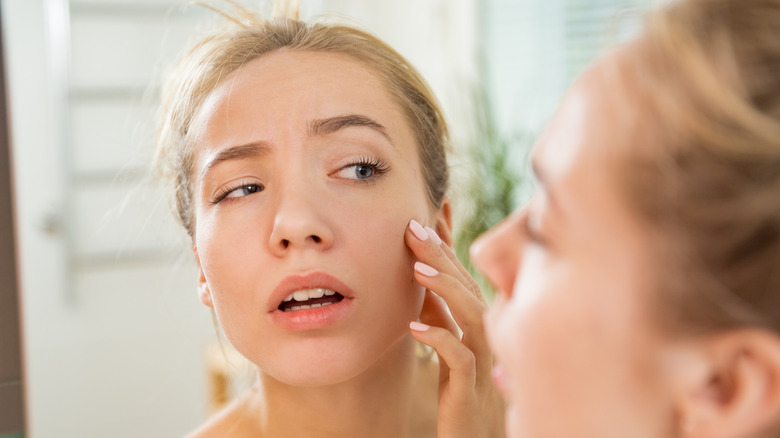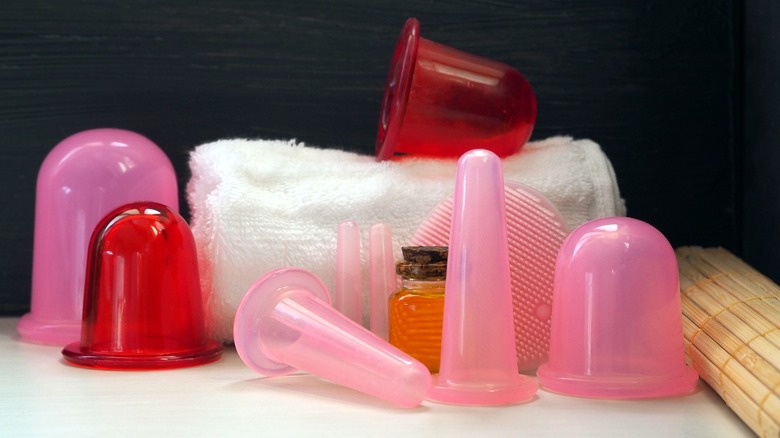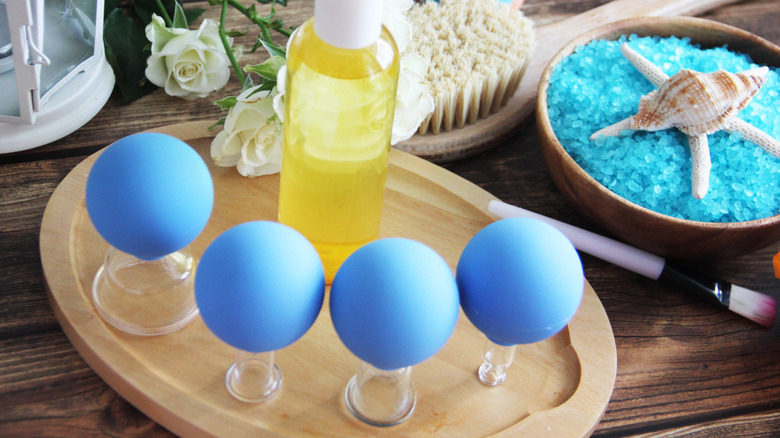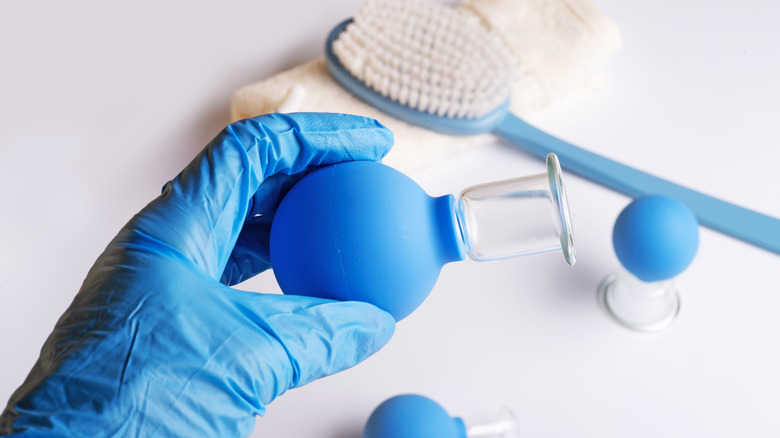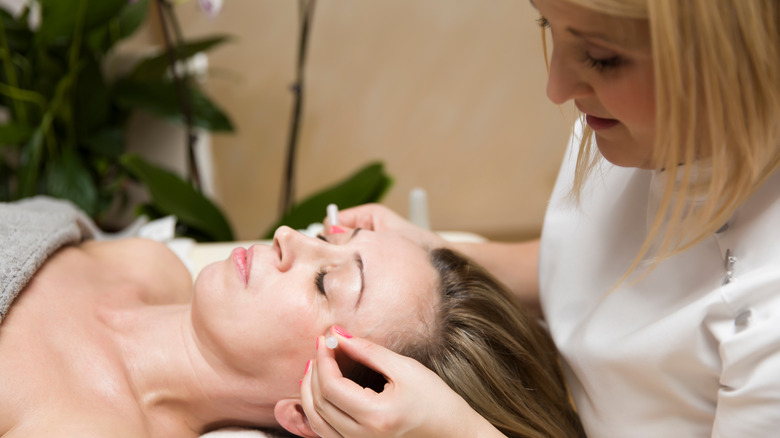Everything You Need To Know Before You Try Facial Cupping
You've probably heard of traditional cupping, a holistic treatment used since the inception of Chinese and Egyptian medicine. This ancient technique's exact origin is not well known, but it's been used for centuries, and now the modern world is catching up. Celebrities have taken to cupping like ducks to water – Kim Kardashian practically introduced the world to facial cupping, while stars like Gwyneth Paltrow took body cupping for a spin as soon as the treatment gained traction. Of course, the rest of us were immediately curious as to what all the fuss was about.
"Facial cupping works by using suction to pull the facial muscles, promoting circulation," dermatologist Michele Green, M.D., tells Self. The result is smooth, plumped skin. Facial cupping might even make your eyes appear more open and awake, celebrity esthetician Lora Condon adds. So how, exactly, does putting small suction cups on your face yield these results? Condon tells Self the suction drains retained fluid from the face, doing away with puffiness. The results are not permanent, however, so if you like what you see after a facial cupping session, you'll need to subject your face to those little suckers again to maintain your newfound glow. If you're as intrigued as we are, learn everything you need to know before you book your first facial cupping session.
Facial cupping vs. body cupping: What's the difference?
Many of us are familiar with body cupping — celebrities have been endorsing it on social media quite a bit in the past couple of years — but what makes facial cupping different from this popular treatment? According to clinical dermatologist Akanksha Shah Sanghvi, M.D., (via eMedi Health) the difference lies in the technique and tools used. Body cupping is executed with bigger, sturdier cups than those used for facial cupping, and they're typically made from materials like earthenware, bamboo, or glass, Sanghvi adds that body cupping can be done using various cups, which include hot air and heated cups. They're also left on the skin for longer than when you get facial cupping.
The main aim of body cupping is to relieve pain, and the larger cups with their higher pressure levels can accomplish this. Because these cups have stronger suction and are left on the skin for longer, bruises are often inevitable. Facial cupping, on the other hand, has an entirely different purpose — the goal is not to relieve pain but to restore the skin's youthful glow. "Over time this practice improves the complexion and diminishes fine lines and wrinkles," Ananda Emily Reese, LAc, of Reese Acupuncture tells Healthline.
Here's how cupping actually works
This seemingly torturous treatment can seem, well, crazy, but there is a method to the madness. According to the Times of India, the idea behind cupping is that the small vacuums created by the cups balance the body's energy flow, which is also referred to as "qi."
Facial cupping uses the small vacuum pockets created by the cups to work like a facial massage. As the skin is subjected to the vacuum created by the cup, blood flow increases, giving your skin that extra glow. The fresh blood rushing to the area can help new blood vessels form. Facial cupping also creates sterile inflammation, which simply means that the skin suffers controlled microtears and trauma. The body reacts to this by sending platelets and white blood cells to the area, which is what gives your skin that post-cupping glow.
It's easy to pass this strange facial treatment off as a fad, but dermatologist Noopur Jain, M.D., tells the Times of India, "It is indeed effective." In addition to providing your facial skin with a much-needed massage, facial cupping also works to extract surplus fluid that is then drained by the body's lymphatic system. The result is more elasticity, thanks to muscles and pores being tightened throughout the process. Jain says you almost get the effect of a facelift, and you might even notice that your jawline is more pronounced. Okay, now they have our attention.
You can reap some sweet benefits from facial cupping
One of the best benefits of facial cupping is probably its ability to give collagen production a boost. Clinical dermatologist Akanksha Shah Sanghvi, M.D., explains that "cupping can stimulate the release of nitric oxide, which helps in the accumulation of collagen, thus facilitating skin repair." In addition to giving collagen a boost, facial cupping can also tighten skin, which means fewer wrinkles. Some people might even notice that their chin and jawline look more defined after a few facial cupping sessions.
You can also expect to see clearer skin — facial cupping can help to unclog pores and shrink them, giving your skin that youthful glow. Applying your favorite skin-loving ingredients after a cupping session can help your skin absorb the products better, enhancing the results, Sanghvi says. In addition to clearing up breakouts, facial cupping might also be used to help treat other skin conditions like psoriasis, eczema, and urticaria. It can also nip acne in the bud if you use it alongside herbal facial masks, a 2018 study published in Acta Dermatovenerologica APA. Aside from promoting clear skin, facial cupping can help reduce swelling or puffiness and improve the skin's microcirculation as well, per a 2020 study published in Biomedicals Optic Express. Last, but not least, this treatment might also aid in the relief of headaches when used on the forehead, sinuses, and nose.
Be careful with cupping if you have sensitive or fair skin
While there's no doubt that most of us would love to reap the benefits of facial cupping, it's not a great option for everyone — especially if you have skin that's sensitive or fair. Speaking to Self, dermatologist Michele Green, M.D., explained that facial cupping can potentially cause bruises and broken capillaries in these individuals. "In addition, the repetitive suction can break the collagen fibers in the skin," she adds.
That is definitely not what any of us want. When it comes to gauging whether your skin is too fair or sensitive for cupping, the best option is to speak to your dermatologist or esthetician. If you're unsure, do not try facial cupping at home to see what happens. It's your face, and you most certainly don't want to look like you've been in a boxing match.
Celebrity esthetician Kerry Spindler explains on her website that it's also important you don't attempt facial cupping if you have certain health conditions. If you have bad swelling, tumors, cancer, inflammation, heart disease, or thrombosis, it's best to wait until the condition clears up. If you do happen to have any of the health conditions listed, you might still be able to get facial cupping in some instances, but you'll need to check with your dermatologist or esthetician first.
Cupping might not be a good idea if you have certain skin conditions
Aside from taking your general health and skin type into account, it's also vital you be aware that facial cupping shouldn't be performed if you deal with certain skin conditions. Steer clear of facial cupping if you have broken skin or any active skin rashes or acne breakouts on your face, skin expert and facialist Antonia Burrell warns. She tells Sheerluxe that individuals dealing with level 3-4 rosacea should also be very careful, and you should under no circumstances attempt facial cupping if you're nursing sunburnt skin.
Speaking to Professional Beauty, cosmetic doctor Usman Qureshi, M.D., explains that facial cupping also shouldn't be performed on any direct veins or areas affected by deep vein thrombosis. That's not all — acupuncturist and massage therapist Sakina Di Pace adds that you should also forgo this treatment if you "have very thin skin that bruises easily, rosacea, open wounds, sores, or burns on your face and/or neck, a history of allergic reaction, multiple moles in the treatment area, or skin cancer."
Another instance where you'll need to postpone facial cupping is after you get botox or fillers. Di Pace says the cups' suction can mess with the fillers and botox, causing it to move underneath the skin (we all know that can be quite the nightmare). Wait at least three to four months after getting botox or fillers before you attempt facial cupping.
You might deal with some bruising
Most of us are aware that traditional body cupping tends to leave noticeable bruises, and, unfortunately, facial cupping, albeit gentler, can still leave a bruise or two. Most experts insist that facial cupping typically doesn't lead to any facial bruising, but that's only the case if it's done right. Speaking to Oprah Daily, acupuncturist and esthetician Lorraine Lavenita explained that bruises from cupping are usually a direct result of inhibited blood flow. Therefore facial cupping experts take care to keep the cups moving across the face at all times — the cups won't be placed on your face and left there for a few minutes like they are with body cupping; they need to be continuously gliding over your face. This way, bruising can't occur.
Of course, if facial cupping is done incorrectly, you might deal with some very nasty bruising. Dermatologist Noopur Jain, M.D., says bad facial cupping techniques can not only leave you with nasty bruising but can also cause infection and skin discoloration. That's why it's a good idea to let an expert perform this treatment.
You might deal with other mild side effects
It's always good to know what kind of side effects you can expect from a treatment, and even though facial cupping isn't invasive at all, you might deal with some mild discomfort afterward. Celebrity esthetician Kerry Spindler shares that side effects usually appear right after a cupping session. One of the most common side effects is redness (which makes sense — you did just suction your face with small cups, after all). Some people also experience dizziness and nausea (way less nice, but manageable). The Times of India notes that infection is a possibility, as well as breakouts. Some people also experience cold sweats after a facial cupping session.
While side effects are common directly after the treatment, some people experience them during facial cupping. If you feel unwell or experience any pain during the treatment, tell your dermatologist or facial cupping expert immediately.
Here's how to do facial cupping at home
So, you're totally hooked on the idea of facial cupping, and you want to give this treatment a whirl at home. Before you dive in and start to randomly apply suction to your face, you should know a few things.
First, make sure you have the right cups — they need to be small and soft. Second, make sure you cleanse your skin beforehand. Never try cupping on dry skin; you'll risk causing some serious damage. Acupuncturist and massage therapist Sakina Di Pace says she applies oil, like prickly pear seed oil, to the skin prior to cupping. She adds that serums or lotions containing active ingredients are also great options, since cupping will increase absorption. Apply these products before the oil.
Once you start the cupping process, Di Pace says to move them horizontally across your skin — don't drag them downward. Use the bigger cups in your kit for your forehead, cheeks, and jawline. Work the cups from the center of your face outward. "You can then move on to the eyes and lip areas with the smaller eye cup," Di Pace says, but she warns that you should be careful of hurting the fragile under-eye skin. "Never slide the cup here, only squeeze and release it," she says. You can also use cupping to plump your lips. Remember to keep the cups moving at all times to prevent bruising.
What to look for when you buy a facial cupping kit
If you're set to try facial cupping at home, it's crucial you get a quality set of cups. We probably don't have to tell you that there are thousands of facial cupping kits out there. Knowing what to look for when buying a kit can make the selection process much easier.
The Chalk Board explains that professionals typically use cups made from glass, ceramic, or silicone. When you plan on doing facial cupping at home, however, you should steer clear of the "fancy" stuff, and opt for silicone-based cups. A good kit will include different-sized cups that can be used on various parts of your face. Lure Essentials sell a facial cupping kit that includes two large and two small cups. Additionally, it includes an exfoliating brush you can use on your skin before you start your cupping session. This product has hundreds of five-star reviews, so it might just be the perfect kit to kick off your at-home cupping session.
Do experts recommend you do facial cupping at home?
While facial cupping kits are readily available, it doesn't necessarily mean that you should be doing this treatment at home. When in doubt, it's always wise to look at what experts have to say on the matter. Celebrity esthetician Kerry Spindler explains that, despite being a non-invasive procedure, facial cupping is still done best by a professional. "Facial cupping done by a licensed esthetician will be more targeted and effective because they understand the structure of the face," Spindler writes, adding, "They know what to do at different points with different skin types."
Spindler is not the only expert who recommends you see a professional for this treatment. Dermatologist Noopur Jain says that even though social media promotes doing this treatment at home by yourself, it's not necessarily the best option. "I will suggest everyone get it done only at professional clinics or at specialists," adding that going to an expert will ensure you don't deal with any side effects like bruises or skin discoloration.
What to look for when you decide on a facial cupping specialist
If you're deciding to ditch the idea of DIY facial cupping and are looking for a professional to do it, there are a few things you can look for to ensure the person you make an appointment with knows their stuff. First, you'll want to look for an esthetician that has experience administering this treatment — the more training they have and the more experienced they are, the more likely it is that you're going to love the results.
Before you go to just any salon, check their reviews online. Are people happy with the treatment? Did they experience any side effects? Are the reviews all positive or are they overwhelmingly negative? All this will help you decide whether that esthetician is worth going to. Something else to look out for or ask the salon is whether the esthetician is certified. You can also ask how long they've been performing facial cupping to get an idea of how much experience they have with this specific treatment. Last but not least, Google is your friend when it comes to finding facial cupping experts in your area. Do a quick search to find a list of salons near you, then vet them according to the criteria mentioned above.
What to expect at your appointment
Facial cupping usually takes about 10 minutes. Some estheticians offer other facial treatments alongside cupping, in which case the procedure can take up to 30 minutes.
Senior Editor of Oprah Magazine, Jonathan Borge, tried facial cupping and reported back on his experience in Oprah Daily. He mentioned that getting facial cupping done by an expert was a more satisfying experience than doing it at home. Borge went to a licensed esthetician and acupuncturist and described the experience as "soothing." Borge says that, upon arrival, the esthetician cleansed his face and proceeded to apply oil to his skin to ensure there was enough lubrication for the cups to move smoothly. It's not typically a painful experience at all, and the only disconcerting thing you might experience is the popping sound the cups make as the esthetician moves them across your face. "Cupping felt the way getting your head scratched does — relaxing," Borge writes, adding, "After it was over, [the esthetician] suggested I leave the oil on my skin and go about my day."
Ananda Emily Reese, LAc, tells Healthline you can enhance your facial cupping results if you do it alongside acupuncture treatment. "If someone is coming to see me just for facial acupuncture, I do some general balancing points on the hands and feet, facial massage, then cupping, then needles," Reese says. She suggests you do a cupping session once every week for 10 weeks, then switch to monthly appointments to maintain the results.
Does science back up the benefits of facial cupping?
Facial cupping might be a hot trend right now, but does it really work the way everyone claims it does? What does the science say? Dermatologist Akanksha Shah Sanghvi shares that many of the benefits attributed to facial cupping are simply anecdotal and haven't been proven scientifically just yet. Even Jonathan Borge noted that, after his facial cupping session, he didn't notice a "substantial difference."
So, does that mean that all the benefits associated with cupping are all in the mind? Not necessarily. A 2017 study published in Complementary Therapies in Clinical Practice found that cupping therapy, in general, can dilate capillaries and stretch underlying tissue and skin, increasing blood flow.
As for the benefits, the study couldn't find proof that cupping fades wrinkles and fine lines, but does mention that many of the benefits associated with this treatment are not exactly without merit (though more studies need to be conducted to investigate how cupping is able to deliver the results so many experience). Author of the 2017 study, Duane T. Lowe, speculates that cupping activates the body's HO-1 system (which forms part of your cellular metabolism). This activation might be one of the main reasons people experience the benefits they do when they undergo this treatment.
